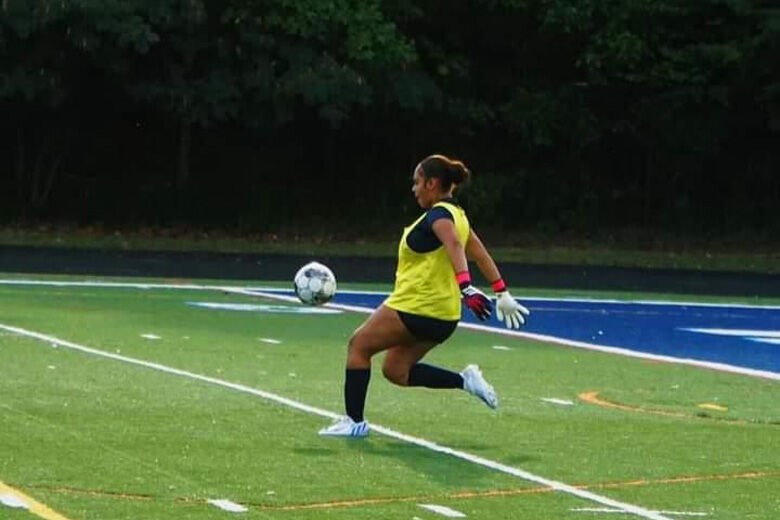From vaping, the cost of school supplies to cellphone policies, the WTOP team is studying up on hot-button topics in education across the D.C. region. Follow on air and online in our series “WTOP Goes Back to School” this August and September.
All summer, Aaliyah Heureaux has been diligently preparing for her final season as a Wildcats girls soccer player at Northwestern High School in Hyattsville, Maryland. The defender has already purchased her cleats, socks and training gear, eager to hit the ground running as practice begins for the upcoming season.
Unfortunately, some of her teammates won’t be ready because they cannot afford the gear needed to compete during the upcoming season.
Last season, as Heureaux played goalkeeper, she recalled allowing her teammates to use her gloves during a match because the ones provided by the school’s athletic department were older and without padding. Other players shared cleats or shin guards during matches before substitutions were made.
“We know a lot of our players don’t really have the opportunities to buy these top-notch cleats, like a lot of other people do,” Heureaux said.
As student-athletes across the D.C. region prepare for the start of their fall seasons, some families are grappling with the high cost of participating in youth athletics, potentially hindering or discouraging their child’s participation.
As the price to participate in high-level youth competitions continues to skyrocket, public school athletics are considered an affordable alternative. However, there are some hidden costs families should be prepared for as their child tries out for the school team.
The costs of youth sports
This video is no longer available.
According to a 2022 survey of parents involved in youth athletics (interscholastic, recreational, travel teams and club teams), an average household spends an average of $883 annually in one child’s primary sport.
While that is a 6% drop from pre-pandemic costs ($935), the average appears lower than expected because of the income range of parents participating in the survey, according to Jon Solomon of the Aspen Institute, who conducted the survey as part of the organization’s annual State of Play report.
“There are parents spending thousands and thousands of dollars a year,” Solomon said. “That tends to be more than in the travel sports arena … the ‘pay for play’ sports.”
Soccer, baseball, volleyball and ice hockey are typically identified as the most expensive sports due to the costs for coaches’ salaries and reserving facilities.
Meanwhile, Solomon said football is often voted as one of the more affordable sports for families because high costs don’t fall back as much on families.
“This is just the reality,” he told WTOP. “In order to make it an affordable sport, you can’t just pass all the costs on to those families.”
Many parents turn to interscholastic athletics because the price barrier is either lower or does not exist. Public school teams have access to facilities, provide transportation and typically hand out the standard uniform tops and bottoms to student-athletes. Some programs recycle uniforms from one season to the next, until they have money to purchase new ones.
However, depending on the sport, many families still face financial hurdles.
Solomon said travel expenses and the cost to use training equipment and facilities — a pool for swimming, or on ice for winter sports — are major reasons costs are high at all levels of youth athletics. Paying for any remaining portions of game day uniforms may also cause some to look for lower-quality solutions.
Heureaux said her family looks for deals on brand-named items in outlet stores, where some items can be highly discounted. She recalled finding Adidas cleats at markdown and even getting an affordable second pair of game-day shoes.
“Me and my mom have learned over the years that you don’t have to spend $1,000 to make something look nice,” she said. “I bought a pair of cleats, very nice cleats. (Adidas) Predators, name brand and everything, for $15 … and then my Messi cleats, I paid half of that.”
Some parents may enter their child into travel or club-level teams — the highest level of youth sports — with the goal of their child receiving a college scholarship offer, or a professional contract. Those organizations often come with highly-regarded coaches and trainers that attempt to improve an athlete’s performance.
However, unlike schools, these organizations charge a sizable fee and put families on the hook for travel expenses.
“Money and resources impact whether kids even play,” Solomon said. “And then if they do play, what is the quality of that experience like?”

Community involvement
Some state and local governments have been stepping up in different ways to help families afford the growing cost.
For example, Fairfax County, Virginia, has developed an athletic council, which includes members of the school system and area agencies. Its job is to discuss “enhancing the availability of sports programs” to all its residents.
Nearby Montgomery County, Maryland, has partnered with sportswear company Under Armour and the Baltimore Ravens to bring girls flag football to its high schools beginning this fall.
Solomon said programs like these are a start but will need continued investment to keep up with standards. “It has to be quality, too,” Solomon said. “Because if it’s not quality, then that in part is what will turn people off and they’ll quit sports.”
Parent groups within a team also help families save money, share resources and even prompt carpools that limit travel expenses. Susanna Heureaux said her daughter’s high school and academy teams have a good network of parents that communicate about the needs for their players.
While acknowledging that the Heureaux family faces financial struggles, Susanna said the goal is to make sure everyone has what they need to play.
“If Aaliyah comes up to me and is like, ‘Mom, my teammate needs cleats and socks,’ we will figure it out and we will help them,” Susanna Heureaux said.
Solomon also recommended parents have conversations with their high school-aged child about their goals in the sport they play. If it is about having fun with their friends, then paying for expensive cleats or classes with a trainer may not be worth a family’s investment.
However, if their child has college prospects, they may want to explore grant opportunities with organizations such as Every Kid Sports, which offers “qualifying families financial support” to pay registration fees and other expenses.
At the end of the day, for Aaliyah, spending loads of money to have the “best drip” won’t help her reach her ultimate goal of receiving a college scholarship.
Fully recovered from her injuries and playing in her natural position, she said her focus is now on her performance and helping the Wildcats win matches this fall.
“It’s not the cleats that make the game. It’s not the uniform that makes the game. It’s you as a player,” Aaliyah said. “As long as you are working hard to be the player that you want to be, it doesn’t matter about the luxury things.”
Get breaking news and daily headlines delivered to your email inbox by signing up here.
© 2024 WTOP. All Rights Reserved. This website is not intended for users located within the European Economic Area.






